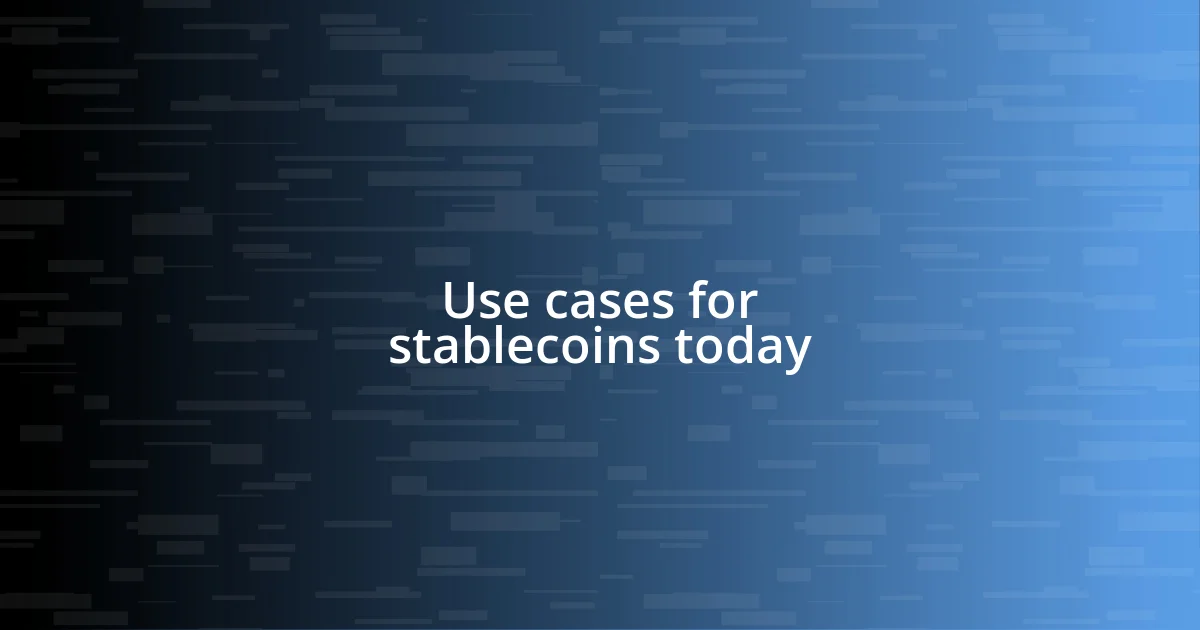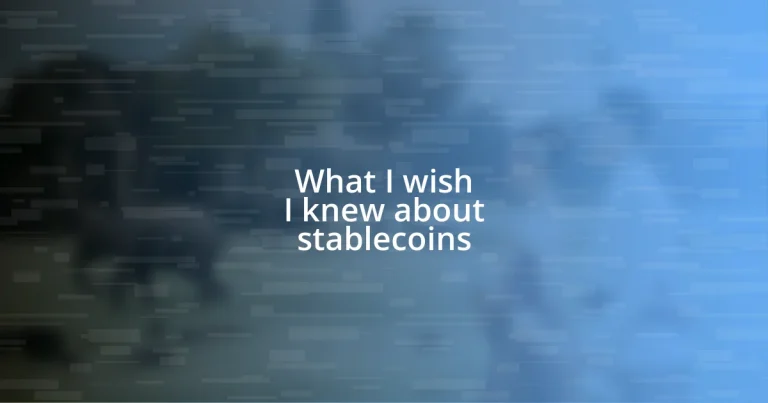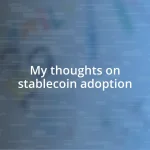Key takeaways:
- Stablecoins bridge the gap between volatile cryptocurrencies and stable traditional currencies, with three main types: fiat-collateralized, crypto-collateralized, and algorithmic.
- Practical uses of stablecoins include international transactions, yield farming in DeFi, and acting as a safe haven during market volatility.
- Key factors to consider when choosing a stablecoin include its underlying structure, liquidity, community support, and staying informed about market conditions and regulations.

Understanding stablecoins basics
Stablecoins serve as a bridge between the volatility of cryptocurrencies and the stability of traditional currencies. I remember my first encounter with Bitcoin; its price swings were dizzying. The thought of using something stable, like a stablecoin pegged to the dollar, made me realize I could finally dip my toes into the crypto pool without the fear of losing my entire investment overnight.
When I first learned about the three main types of stablecoins—fiat-collateralized, crypto-collateralized, and algorithmic—I was intrigued by the variety in how they maintain their value. Fiat-collateralized stablecoins, for example, are backed 1:1 by a reserve of real-world assets, such as the U.S. dollar. Isn’t it fascinating how different approaches can attract different kinds of investors, depending on their risk tolerance and investment strategy?
One thing I wish I had understood better before diving into stablecoins is the importance of transparency and governance in the projects behind them. I recall the anxiety of wondering if the company issuing the stablecoin truly had the reserves they claimed. Wouldn’t it be reassuring to know that the stablecoin you’re investing in is backed by genuine assets and regulated oversight? Understanding the underpinnings of stablecoins can make a world of difference in feeling secure and confident in your investment decisions.

Types of stablecoins explained
Fiat-collateralized stablecoins are perhaps the most straightforward for investors to grasp. They are backed by traditional currencies, which are held in a reserve, providing a sense of security. I remember the relief I felt when I realized these types of stablecoins, like USDC or Tether, offered a stable value without the rollercoaster of market fluctuations. Understanding this gave me confidence, knowing there was a tangible asset anchoring my digital funds.
On the other hand, crypto-collateralized stablecoins work a bit differently. They are backed by other cryptocurrencies and often over-collateralized to account for volatility. The first time I got into using something like DAI, I was surprised by how it created a balance between staying decentralized while still offering stability. Similarly, algorithmic stablecoins, which rely on smart contracts to maintain their peg, can be quite appealing but involve a higher risk. These differences shape our approach to investing, so here’s a quick breakdown of the types:
- Fiat-Collateralized Stablecoins: Backed 1:1 by traditional currencies.
- Crypto-Collateralized Stablecoins: Backed by cryptocurrencies but often over-collateralized.
- Algorithmic Stablecoins: Utilize smart contracts to manage supply and maintain price stability.
It’s instrumental to delve into these categories to understand how each type aligns with individual investment goals and risk comfort levels.

Use cases for stablecoins today
Stablecoins have found practical use cases across various sectors today, making them an appealing option for many. For instance, I often use stablecoins for seamless international transactions. The speed at which I can send funds across borders without traditional banking fees is impressive. It brings a sense of empowerment and convenience that I wish I had known about earlier in my investment journey.
Additionally, many decentralized finance (DeFi) platforms allow users to earn interest on stablecoin deposits. I remember my excitement when I first explored yield farming using a stablecoin like USDC. Earning interest while holding a stable asset felt like free money, and it opened my eyes to the potential of passive income opportunities in the crypto space. The security of knowing that my investment wouldn’t fluctuate wildly was a game-changer for me.
Moreover, stablecoins serve as a reliable medium of exchange in cryptocurrency trading. In my experience, I often convert my volatile crypto holdings into stablecoins during market downturns. This strategy not only helps mitigate risks but also allows me to jump back into the market at the right moment. It’s fascinating how stablecoins provide a safety net while still keeping me engaged in the trading world.
| Use Case | Description |
|---|---|
| International Transactions | Stablecoins enable fast and cost-effective cross-border transfers. |
| Yield Farming | Users can earn interest on stablecoin holdings through DeFi platforms. |
| Trading Strategy | Stablecoins act as a safe haven during market volatility. |

Risks associated with stablecoins
When diving into the world of stablecoins, it’s crucial to consider the risks that come along with their supposed stability. For instance, when I first invested in a fiat-collateralized stablecoin, I felt a wave of reassurance. The idea of my investment being backed by actual currency was comforting until I learned about the risks linked to the transparency and management of reserves. What if the issuer of those stablecoins didn’t have the sufficient reserves they claimed? This uncertainty made me realize that even so-called stable assets can hold hidden risks.
Moreover, crypto-collateralized stablecoins, while innovative, carry their own set of dangers. I remember exploring DAI and felt empowered by its decentralized nature. However, during market volatility, I began to worry about the over-collateralization mechanism. What happens when the collateral’s value drops significantly? Those sudden price plunges can trigger liquidations, leaving investors like me in a precarious position. This taught me that a sense of security doesn’t always equate to stability.
Algorithmic stablecoins caught my attention as a fascinating concept, yet they often operate on a delicate balance that can tip unexpectedly. I recall the excitement I felt during discussions about their potential to maintain price stability without collateral. Yet, after seeing how quickly market sentiments can shift, I had to reconsider my position; the reliance on smart contracts can lead to unforeseen complications. Isn’t it unsettling to think that a line of code could dictate the fate of my investment? This sparked a healthy skepticism regarding the solidity of such systems.

Choosing a stablecoin for investment
When it comes to choosing a stablecoin for investment, I think it’s essential to evaluate its underlying structure carefully. For instance, when I selected USDT for my portfolio, I didn’t just look at its popularity; I dug into how it maintained its peg to the US dollar. Understanding whether a stablecoin is fiat-collateralized, crypto-collateralized, or algorithmic can significantly influence your experience. Have you ever wondered how much you trust the security of the backing behind a stable asset?
Another factor to consider is the liquidity of the stablecoin you choose. I had an experience trying to cash out on a less popular stablecoin and found myself struggling with limited options. The more widely adopted the stablecoin, the easier it is to buy and sell, which can save you a lot of hassle. It’s the kind of lesson that sticks with you: ensure you can access your funds when needed!
Lastly, community and regulatory backing are worth noting. I remember feeling a lot more secure investing in stablecoins that had robust community support. It felt like there was a safety net when I knew others were also using and believing in the same asset. As I navigated various choices, I often asked myself—does this stablecoin have a future? Seeing strong community engagement can really boost my confidence in a long-term investment strategy.

Future trends in stablecoins
The landscape of stablecoins is evolving, and I can’t help but feel excited about where it’s heading. One trend I’ve noticed is the growing interest in central bank digital currencies (CBDCs). Countries are exploring ways to issue digital versions of their fiat currencies, and the thought of this standardization makes me wonder if it will redefine stability. Could we see a future where CBDCs become the gold standard for stablecoins, offering unparalleled trust and backing?
Emerging technologies like DeFi (decentralized finance) are also reshaping the future of stablecoins. I vividly remember the thrill I felt when I first utilized a stablecoin in a DeFi lending protocol. It was fascinating to see my assets work for me, yet it raised questions about risk and governance. How will these innovations impact the security of stablecoins? Directly tying stablecoins to these platforms could bring about new opportunities, but I worry about the volatility that may arise from misplaced confidence in these systems.
I’ve also observed a push towards more transparency and accountability in the stablecoin sector. I recall my own hesitation before investing because I craved clarity on how my currency was backed. With increasing regulatory scrutiny, I believe we’ll see more stablecoins adopting audits and proof-of-reserve mechanisms. Will this heightened accountability make me feel more secure as an investor? It sure seems possible, and I’m hopeful that clearer guidelines can pave the way for sustainable growth in the stablecoin market.

Practical tips for stablecoin adoption
When adopting stablecoins, start with a clear understanding of your goals. I once jumped into investing without defining my objectives and quickly found myself overwhelmed. Ask yourself: are you looking for a safe haven, earning interest, or simply a way to transact? Establishing your purpose can guide you to a suitable stablecoin.
Another critical tip is to regularly monitor market conditions and regulatory changes. In my early days, I became too comfortable with the stablecoin I chose and neglected to stay informed. It was a wake-up call when I learned about impending regulations that could impact liquidity. Staying updated can help you make timely decisions and avoid unnecessary pitfalls—trust me, it’s worth the effort.
Don’t forget about diversification. I learned the hard way by putting all my funds into a single stablecoin, which left me vulnerable to market shifts. By spreading your investments across various stablecoins, you not only reduce risk but also open doors to different opportunities. How would you feel knowing that your portfolio can weather various market conditions? It definitely brings peace of mind.














